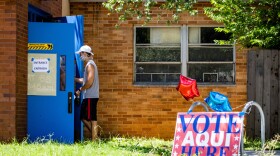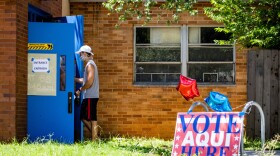Early voting in the 2020 general election begins Tuesday. The coronavirus pandemic has led to some changes to the voting process, but many of the basics remain the same.
"Expect to see social distancing inside, and outside if necessary," Travis County Clerk Dana DeBeauvoir said. "And the booths are also separated from each other inside."
Voters will be provided with a plastic finger covering and a popsicle stick so they can sign the electronic poll book and select their choices on the ballot-marking device without directly touching anything.
The coronavirus pandemic has also caused the county to get creative in where it sets up early voting locations — like using hotels instead of grocery stores. DeBeauvoir encourages people to check the map of early voting spots in Travis County before they head out.
DeBeauvoir also reminds people to bring one of the accepted forms of photo ID. People without an ID are encouraged to bring some proof of address, like a utility bill. In this case, DeBeauvoir said you will "probably have to vote a provisional ballot and then you'll be given the opportunity up to six days after the election to come in and show ID so that your provisional ballot will count."
Travis County voters’ ballots will look a little different this year. In an effort to help voters get through their ballot more quickly, all candidates running unopposed have been placed at the end.
"It's the first time we've used it here," DeBeauvoir said. "It's allowed by Texas law, and it does make it easier."
Listen to the interview with DeBeauvoir below or read the transcript to find out more about early voting in the 2020 general election in Travis County, including how the https://youtu.be/76pR4HeWwAk" target="_blank">paper-trail voting system works.
This transcript has been edited lightly for clarity:
Travis County Clerk Dana DeBeauvoir: We have 37 early voting locations, which is more than what we've had in the past. So, we would encourage voters to check. Don't make assumptions about where you're going to go before you check the list and head out. Also, on the County Clerk’s website votetravis.com you can check the wait times of these early voting locations so that you won't get stuck in a line. We've got lots of resources in the field, and if we spread ourselves out, nobody's going to have to wait at all.
Expect to see social distancing inside and outside if necessary. And the booths are also separated from each other inside. Everybody wears a mask, and the voter doesn't have to really touch anything. They're given some PPE [personal protective equipment] — a little plastic finger covering so that they can sign the e-poll book and then a popsicle stick so that they can make their choices on the ballot-marking device without having to touch either of those things.
KUT: Remind us what forms of ID people need to bring with them when they're voting in person.
You need to bring a photo ID produced by the Texas Department of Public Safety, so a driver’s license, an ID card, anything like that. You can also use a passport to vote. You can use some other forms of military and ambassador-type photo IDs.
The one ID that surprises people that I think a lot of people don't know is not acceptable is a student photo ID. University IDs are not allowed. And that may seem a little odd, but that is the way the ID law in Texas goes.
What happens if a voter gets to the polls without one of those approved forms of photo ID?
There are a number of ways to address it so that the voter still gets to vote. If you don't have an ID, we're probably going to ask you to sign a form. It's better if you can bring something that shows where you live. A utility bill is perfect. And then you will probably have to vote a provisional ballot, and then you'll be given the opportunity up to six days after the election to come in and show ID so that your provisional ballot will count.
Can you describe for people what the voting process is actually like — what the machines are like?
We will be using our new paper-trail voting system now for the third time. But because it's a presidential election, a lot of people are going to see it for the very first time. It is a ballot-marking device. It doesn't have any memory in it. So, when you make your selections, the machine erases everything that's in it when it prints out your ballot card.
So, as soon as you have your paper trail in your hand, you can step away from the machine and let the next voter use it. And on the way to the ballot box, voters have a new job with this particular voting system. They are asked to voter verify the readable text on their paper trail. So, after you've checked it on your machine and you've printed out your paper trail, again, check the paper trail [and] make sure all the choices on there are the ones you want.
If something has happened, if you changed your mind about something, it's all OK. All you have to do is go back to the election judge and tell him that you want a do-over, and we'll spoil your first ballot and set you up to get a second ballot. And we don't make you go to the end of the line.
When are you expecting the longest lines and the biggest crowds during the early voting period?
We're expecting the biggest crowds on the first day. We hope we get a great showing on the first day. And then on the last three days. Wednesday, Thursday and Friday of October 28, 29 and 30 should be our busiest. And we hope people won't wait until the last minute.
But if [they] do, we've made special arrangements for five of our locations to offer late hours on [Oct.] 28, 29 and 30. They will be open until 9 p.m. for the mega centers. So, there are five locations for early voting that will have late hours on the last three days.
Earlier this year, some poll workers were nervous about the pandemic. What about staffing levels for this early voting period?
It's been a challenge to find enough people willing to work this election, not because the election isn't fun and intriguing, but because people are concerned about being around that big a crowd. And we understand that. So, we've had to build in some safety features to prevent us from being caught short-handed come the first day of early voting.
We want everything to open on time and smoothly and so we have a group that we've formed of extra people we've recruited that can be called in at the last minute. We do the same thing on Election Day, and this is something we learned is a way to deal with the virus, the threat of the virus. People just get scared.
I think we're going to be OK. I do still need people to come and help us work Election Day and also election night at the counting stations. So, call us at 512-238-VOTE or send us an email and join in with us.
For voting in person, are there any other strategies or tips that you really want early voters to know about?
I think they'll find that they can get through their ballot pretty quickly, especially if they've already researched their candidates and they're clear about what they want to use. We have placed all of the candidates who are not opposed at the end of the ballot. So, at the top of the ballot, you're going to find all the ones where you have to make a choice or where you have an option to make a choice.
It's the first time we've used it here. It's allowed by Texas law, and it does make it easier. We still have all the candidates’ names on the ballot, but it's just organized so that voters can get through the ballot more quickly.
And also, keep in mind, too, that at the very end of your ballot, you're going to find some city and school races depending on your particular area. So, go all the way through. The ballot-marking device is going to have you look at each page anyway. Please don't forget the last part of the ballot.
Got a tip? Email Jennifer Stayton at jstayton@kut.org. Follow her on Twitter @jenstayton.
If you found the reporting above valuable, please consider making a donation to support it. Your gift pays for everything you find on KUT.org. Thanks for donating today.






